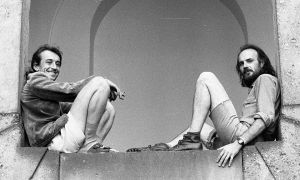Petr Kvíčala is a painter who has, since the mid-1980s, been focusing on ornament production. A basic element of his creative language can be found in ornamental lines, most often waves, broken lines or loops which he combines, reproduces, melds and layers them in various ways. His inspiration for this abstract and radically reduced language was originally the landscape, through which Kvíčala, sometime around 1985, realized the autonomous expressive possibilities of geometrical linear elements rhythmically repeated on the image’s surface.
It is characteristic for the rise of Czech post-modern sensibility that, at the turn of the 1980s/1990s, theorists associated Kvíčala’s painting with expression outside the avant-garde of modern art. They pointed out similarities between his works and ornamental paintings of folk architecture (the Waves /Vlny series, 1991). Likewise, they noted his work's relationship to abstract cave paintings from the Stone Age. Kvíčala indicates his inspiration from "low" culture by using elements from artistic crafts or from industrial manufacturing. This is reflected in the names of his paintings (Wallpaper / Tapety, 1987-88; Holiday Tablecloths for Weekdays / Sváteční ubrusy pro všední den 1992-94; Embroidering / Vyšívání, 1993). However, at the initial level, Kvíčala is not concerned about a post-modern game of aligning various languages, but rather he wishes to revive ornamentation as such. He values its visual effectiveness, its rational order and, last but not least, its potential for continuous variation. Kvíčala expressed great inventiveness and a taste for experimenting in his intentionally-abridged idiomatic dictionary. Among his works we can find a procedural painting (60 Days of Red, Blue and Yellow / 60 dní červené, modré a žluté, 1996), or monochromatics and painted installations (Borders / Okraje, 1994).
Since the first quarter of the 1990s, he has also created painted objects, transfering themes for his paintings onto practical objects. He creates designs for clothing and has created a number of carpets of his own design. During the second half of the 1990s, he began working with architects. He has painted several interior paintings (murals). He also participates on concept development for specific spaces (wall mural in the Sports Hall in Litomyšl, 2001; decoration for the upholstery for a seating set in the dům U závoje in Prague, 2003; a ceiling mural for the Deutsche Bundesbank in Chemnitz, 2004; the Celebration Hall at Reduta in Brno, 2005). Kvíčala’s paintings, developed parallel to his other work between 2003-2005, express his interest in the optical effects of parallel lines, and in recent months he has turned to more classic forms of contemporary abstraction.
Tomáš Pospíszyl


